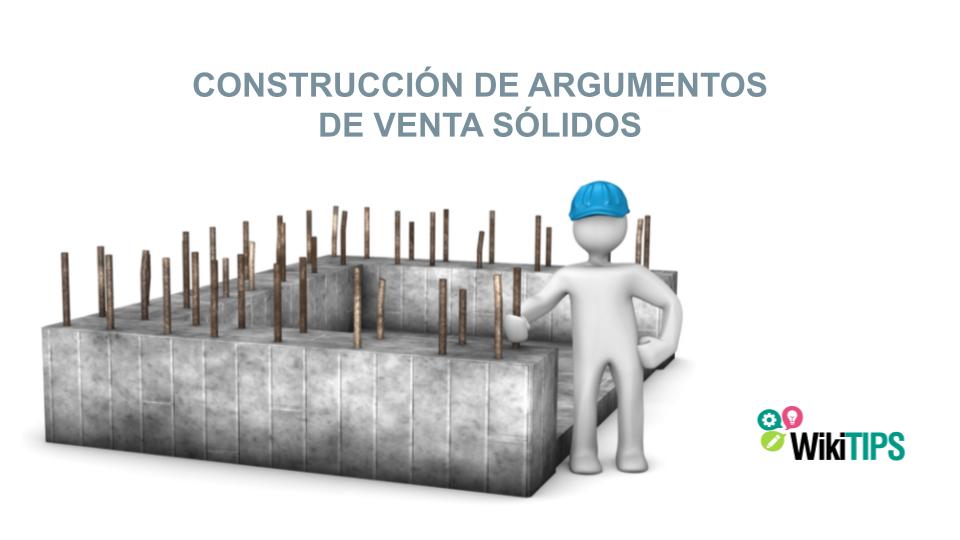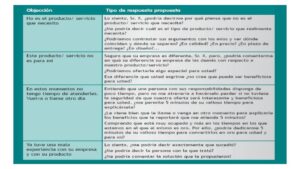
CONSTRUCCIÓN DE ARGUMENTOS DE VENTA SÓLIDOS
Acelera tu empresa con estos consejos de expertos sobre «Construcción de argumentos de venta sólidos». ¡Analiza y descubre esta TIP!
En esta tip vamos a hablar argumentos de venta sólidos, de cómo elaborarlos y como agruparlos en un argumentario. Uno de los pasos fundamentales del emprendedor a la hora de comercializar sus productos o servicios, es construir un argumentario de ventas. En esta tip te explicamos cómo desarrollar argumentaciones sólidas con una clara orientación al cliente asumiendo principios básicos de neurociencia.
Un argumentario de ventas es un documento en el que se recopilan los principales razonamientos que pueden utilizar los vendedores de un producto o servicio para convencer al comprador de que le ofrecemos la mejor opción disponible en el mercado para cubrir sus necesidades.
No se trata de crear un arsenal de argumentos que utilizaremos para presionar al cliente, venta enlatada, sino de plasmar en un documento las ventajas y beneficios que aporta el producto teniendo en cuenta el perfil y las necesidades del cliente.
Los argumentarios de venta se componen de dos partes fundamentales: Los argumentos y las objeciones y su tratamiento.
Se trata de un documento que reviste la mayor importancia porque
- Mejora los recursos técnicos de los responsables de venta.
- Evitar improvisaciones delante del cliente.
- Optimiza el discurso que emplean para generar interés y convencimiento.
- Motivar al equipo de ventas.
- Homogeneizar el discurso por parte de todo el equipo comercial
- Agiliza la gestión de clientes.
- Acelera el proceso de acogida de nuevos vendedores.
- Es un documento que ayuda a la reflexión y a la búsqueda de soluciones persuasivas en la relación con el clientes.
Distingue entre características, ventajas y beneficios:
El primer paso a la hora construir argumentos de venta sólidos, es que estos deben fundamentarse en beneficios significativos para el cliente al que nos dirigimos.
Uno de los errores más comunes de los vendedores novatos es construir sus argumentos basándose en las características del producto. Por ejemplo a la hora de vender un coche hablan de centímetros cúbicos o exponen una retahíla de acrónimos que nadie sabe lo que significan. O cuando vendemos algún hardware hablamos de procesadores, memorias, etc. En ambos casos, lo que el cliente quiere oír, es que puede hacer el producto por mí. Lo que corresponde en ambos casos al vendedor es escuchar y entender a su cliente y a continuación hacerle ver las soluciones y beneficios que podemos ofrecerle.
Normalmente, las características sustentan las ventajas y es evidente que en productos con una alta carga tecnológica, hardware, software, maquinaria industrial, etc. Habrá que hablar de características cuando llegue el momento y el vendedor deberá estar perfectamente capacitado para dar respuesta a todas las dudas que plantee el cliente, pero la verdadera detonadora de la venta es el beneficios.

¿Razones o emociones?
La neurociencia nos pone de manifiesto que nuestro cerebro se descompone en tres: El córtex en donde reside la razón y la lógica, el cerebro límbico que se encarga de las emociones y el cerebro reptiliano que se ocupa de los instintos.
En general a todos nos gusta pensar que nuestras decisiones de compra las tomamos tras un razonamiento concienzudo. Sin embargo, los estudios demuestran que en más ocasiones de las que creemos son las emociones e incluso los instintos los auténticos promotores de nuestras decisiones. Es más, el córtex se limita a aportar la coartada que justifique la decisión.
La biblia nos cuenta que cuando la serpiente tentó a Eva para que consumiera las manzanas no lo hizo aludiendo a sus minerales, vitaminas o fibra. Le ofreció ser como Dios. Hablamos por tanto de un beneficio emocional. Las compañías de seguros cuando quieren vender un seguro de vida, venden sensaciones, seguridad, tranquilidad ante cualquier eventualidad.
Un vendedor de aviones ejecutivos en Estados Unidos contando sus experiencias, decía que tras una ardua labor de venta racional de un avión, costes de mantenimiento, slots, tripulaciones, gastos de combustible, amortizaciones, etc, sabía que la venta estaba cerrada cuando lograba que el cliente se sintiera como un niño a los mandos del aparato.
Lo cierto es que la venta es un proceso dinámico en el que razón y la emoción juegan su papel y el vendedor tiene que saber aprovechar estas circunstancias. La emoción puede no residir en la argumentación de los beneficios del producto pero si puede asomar en la relación personal entre vendedor y cliente.
La televenta y la publicidad son excelentes escuelas de ventas ya que nos enseñan a estructurar mensajes comerciales en un corto espacio de tiempo. En este enlace podrás ver un video comercial de Rational, fabricante del denominado Self Coocking Center. El video va dirigido a gestores de restaurantes y como verás utiliza un discurso fundamentalmente racional: https://www.youtube.com/watch?v=XdkeXANNIEg
La racionalidad impera en determinadas circunstancias: Cuando se trata de productos funcionales con un alta carga tecnológica y unas ventajas competitivas claras. Tal es el caso de Rational cuyo argumentario está claramente relacionado con valores fundamentales para el cliente: Simultaneidad en los platos, rapidez, limpieza, economía, etc.
La emotividad hace acto de presencia cuando no se dispone argumentos diferenciadores claros. Las guerras en el sector de las cervezas o los refrescos se libran en el terrenos de las emociones. Las marcas luchan por establecer nexos emocionales con el cliente.
En el siguiente verás un spot que relaciona la marca con valores deseables para el cliente.
https://www.youtube.com/watch?v=gXfLl3qYy0k
En este enlace verás lo que un buen discurso comercial que combine razón y emoción pueden hacer por una marca y un producto. Es una obra maestra y una demostración de la eficacia de un excelente argumentario comercial insertado en una historia. Es además un ejemplo muy útil para que como emprendedor construyas marca mientra vendes tu producto: https://www.youtube.com/watch?v=HGOrTVyo0J4
Adapta tus argumentos a tu interlocutor:
Las argumentaciones deben estar concebidas en función de quienes tienen influencia en la decisión final. En este sentido no podemos enfrentar a procesos comerciales simples en los que nos dirigimos directamente al comprador, sea éste usuario o no. Ver tip sobre presentación de ventas.
Podemos igualmente encontrarnos en situaciones más complejas en las que la decisión de compra depende de diversos interlocutores con diversos niveles de influencia. Esta situación es propia de productos o servicios dirigidos a organizaciones. Imaginemos que somos representantes de maquinaria industrial. Podemos encontrar multiplicidad de interlocutores independiente o agrupados en un comité de compras. Cada uno de ellos tiene una relación diferente con el objeto de la venta y tienen también distintos intereses y necesidades. Por ello, cada uno quiere escuchar argumentos diferentes:
El usuario podría estar preocupado con la usabilidad y comodidad, el jefe de departamento con la productividad o el servicio postventa, el financiero con el precio y las condiciones de pago y el SEO con las implicaciones estratégicas en función tales como la competitividad. Incluso el equipo comercial puede tener algo que decir desde el punto de vista de mejoras en el servicio al cliente.
De igual forma no es lo mismo vender a clientes finales que hacerlo a agentes de intermediación (mayoristas, detallistas, etc). En este caso hablamos de personas cuya necesidad esencial radica en la rentabilidad de su negocio. Por ello nuestros argumentos deben fundamentarse en el precio, márgenes, descuentos, acciones promocionales y publicitarias en el mercado, trade marketing, plazos etc. Argumentos como se ve algo diferentes a los que utilizamos con los compradores finales: Eficacia, belleza, rapidez, sabor, prestigio, diseño, etc
Un buen argumentario de ventas debe estar bien estructurado en función de los distintos niveles de interlocución y necesidades, tanto en lo relacionado con los argumentos como en el tratamiento de objeciones.
Cómo construir argumentos de venta sólidos:
Estas son nuestras recomendaciones:
1.-Identifica las fuentes de tus argumentos: La experiencia cliente
Existe una relación directa entre valor y argumento. El valor de una oferta comercial puede radicar en diversas fuentes. Nada mejor que un ejemplo para explicarlo: imagina que hablamos de un concesionario que vende coches de una determinada marca. El satisfactor de necesidad del cliente es el coche en sí mismo.
Es por tanto, una primera fuente de valor, que podríamos llamar nuclear: la marca, el modelo, el diseño, el equipamiento, el consumo, el precio, etc. Todos ellos son fuentes de valor nuclear. Una segunda instancia viene dada por aspectos periféricos: Condiciones de pago, garantía, etc. Una tercera instancia tiene que ver con el vendedor: Reputación del concesionario, trato del, vendedor (amabilidad, información, escucha activa, disponibilidad, etc), puesta en escena, rapidez en la entrrega, servicio postventa, etc.
Todas estas instancias marcan la experiencia del cliente y deben estar contemplados en el argumentario de este concesionario. En un mercado competitivo e indiferenciado, el peso en la decisión del cliente puede venir del buen trato del vendedor más que del diseño. Así que incluye en tu argumentario todo lo que puedes hacer por el cliente tanto a nivel tangible como intangible.
2.-Respalda tus argumentos con evidencias que aporten credibilidad: Estadísticas, experiencias de otros clientes.
3.-Ir más allá de la venta.
Trata de que tus argumentos te ayuden a construir relaciones sólidas con tu cliente. Debes de trascender de la condición de vendedor y hacer que el cliente te vea como un asesor, experto o incluso como un socio: Servicio posventa.
4.-Enfatiza tus valores diferenciales. Pon en evidencia aquello que solo tu puedes hacer por tu cliente.
5.-Vende soluciones, no productos. Apela a la necesidad y evidencia lo adecuado de tu solución. Haz venta adaptativa.
Cómo construir argumentarios de ventas:

Las etapas del proceso seguido por el comprador nos servirán de base para elaborar nuestro argumentario:
1.-Identifica la necesidad y la oportunidad:
Empieza por definir la necesidad o el problema que experimenta tu cliente. Este es un aspecto sobre el que ya has trabajado en la definición del problema durante el proceso de desarrollo del producto. Debes aportar toda la información pertinente al respecto con el fin de dejar claro al lector (gerencia, nuevos vendedores, etc.), cuál es el contexto general en el que se mueve tu oferta.
A continuación, describe la oportunidad generada y,cómo encaja tu producto en ella. Deja claro por qué tu producto o servicio constituye una respuesta adecuada.
2.Tu oferta de valor:
Profundiza en tu oferta de valor. Explica claramente tu propuesta de valor en términos claros de beneficios para el cliente: Funcionalidades, problemas que resuelve, servicios que incorpora el producto, etc. Trata de no olvidarte de nada. Es importante que enfatices aquellos aspectos que te diferencian claramente de tus competidores y te hacen preferible a ojos del cliente.
3.-Prepárate para las objeciones:
Las objeciones siempre llegan y hay que estar preparado para ellas. La experiencia es una excelente herramienta para identificar objeciones y cómo tratarlas. Sin embargo, cuando empiezas con una nueva actividad debes hacer algunos ensayos previos (teatro de ventas) con personas que reúnan características parecidas a las de tus clientes.
Haz una tabla con dos columnas en las que expongas el enunciado de las objeciones y el tratamiento que darás a cada una. Recuerda que un argumentario de ventas es un documento orgánico que hay que enriquecer permanentemente incorporando las nuevas objeciones a las que nos enfrentamos.

En este enlace podrás familiarizarte con las objeciones más comunes con las que se encuentran los vendedores en general y cómo tratarlas pero es obvio que tu sector tendrá las suyas específicas. Lleva un buen listado de casos de éxito con el fin de que puedas esgrimirlos a la hora de enfrentarte a reparos que puedan expresar tus clientes.
Piensa que las objeciones se presentan a lo largo de todo el proceso de la venta, desde la etapa de aproximación en que pides una cita hasta el cierre. Por eso conviene que tu listado de objeciones y su tratamiento correspondiente contemple todas las fases.
APLICA ESTE TIP EN TU PROYECTO
TAREA
Ahora que ya has aprendido todo sobre esta Tip, deberías saber responder a estas preguntas:
- ¿Podrías citar tus tres argumentos de venta más potentes?
- Cita una objeción con la que te encuentres con frecuencia y redacta su tratamiento
- ¿Qué peso crees que tienen las emociones en las decisiones de compra de tus clientes?
- Cita un argumento de ventas que emane de estas instancias:
- Tu producto o servicio.
- Tu empresa.
- Tu como vendedor.
- 💻 PRACTICA con un experto en el próximo webinar práctico.
- 🔎 CONSULTA más TIPs relacionadas con este mismo tema.
- 📖 AMPLIA tus conocimientos descargando este EBOOK.
PIENSA EN TI
- 🚀 IMPULSA tu empresa en el próximo programa de aceleración, ¡reserva tu plaza ya!
- 🥁 PRACTICA con tu proyecto en este webinar práctico, ¡solicita tu plaza!.
- 🌐 CONTACTA con otros emprendedores y empresas, ¡inscríbete y participa en el próximo Networking!
PIENSA EN AYUDAR A LOS DEMÁS
- 🤝COLABORA como voluntario: experto, mentor, inversor, premiando, difundiendo, retando, innovando, creando una TIP…
- 💬 RECOMIENDA este programa para que llegue a más emprendedores por Google.
- 👉 ¡COMPARTE tu aprendizaje!
- 📲 REENVÍA esta TIP 👇








